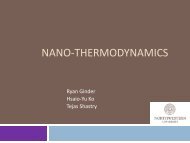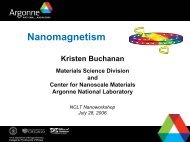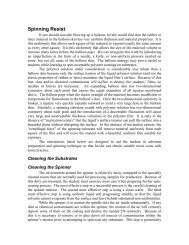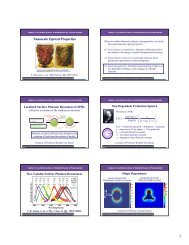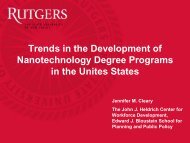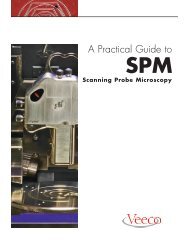Nanomagnetism (PDF)
Nanomagnetism (PDF)
Nanomagnetism (PDF)
Create successful ePaper yourself
Turn your PDF publications into a flip-book with our unique Google optimized e-Paper software.
<strong>Nanomagnetism</strong><br />
Department of Materials Science and Engineering, Northwestern University
Review “Macro” Magnetism<br />
At thermal equilibrium, define:<br />
(1) Magnetization density:<br />
M<br />
−<br />
V<br />
∂F<br />
∂H<br />
V = volume, H = magnetic field,<br />
F = magnetic Helmholtz free energy<br />
(2) Susceptibility:<br />
χ =<br />
∂M<br />
∂H<br />
1<br />
= −<br />
V<br />
= 1 2<br />
2<br />
∂ F<br />
∂H<br />
Department of Materials Science and Engineering, Northwestern University
Review “Macro” Magnetism<br />
NOTE: Force per unit volume (f) exerted on a specimen by an<br />
inhomogeneous magnetic field is:<br />
f<br />
1<br />
= −<br />
V<br />
∂F<br />
∂x<br />
1<br />
= −<br />
V<br />
∂F<br />
∂H<br />
∂H<br />
∂x<br />
=<br />
M<br />
∂H<br />
∂x<br />
To determine M and χ, quantum mechanics is required; in particular,<br />
we need to consider the modification to the Hamiltonian by spin.<br />
Department of Materials Science and Engineering, Northwestern University
Review “Macro” Magnetism<br />
(1) Diamagnetism: negative susceptibility<br />
induced moment opposes applied field (similar to Lenz’s Law)<br />
common for noble gas atoms and alkali halide ions<br />
(e.g., He, Ne, F - , Cl - , Li + , Na + , ….)<br />
(2) Paramagnetism: positive susceptibility<br />
induced moment is favored by applied field (but is opposed<br />
by thermal disorder)<br />
magnetization is immediately lost upon removal of field<br />
common for isolated rare earth ions, iron (group 3d) ions<br />
(e.g., Sm + , Er + , Fe 3+ , Co 2+ , Ni 2+ , ….)<br />
Department of Materials Science and Engineering, Northwestern University
Magnetic Ordering<br />
In solids, electron-electron interactions lead to magnetic ordering<br />
(one of the less well-developed theories in solid state physics)<br />
Types of interactions:<br />
(1) Exchange interaction (electrostatic)<br />
(2) Dipolar interaction (spin-spin coupling)<br />
(3) Anisotropy interaction (spin-orbit coupling)<br />
Department of Materials Science and Engineering, Northwestern University
Exchange Interactions<br />
N. W. Ashcroft and N. D. Mermin, Solid State Physics, Harcourt, 1976.<br />
Department of Materials Science and Engineering, Northwestern University
Types of Magnetic Ordering<br />
If magnetic interactions are consequential and the temperature<br />
is below T c , a solid can exist in the following magnetically ordered<br />
states even with no applied field:<br />
(1) Ferromagnetic: all local moments have a positive component<br />
along the direction of the spontaneous magnetization<br />
(2) Antiferromagnetic: individual local moments sum to zero total<br />
moment (no spontaneous magnetization)<br />
(3) Ferrimagnetic: local moments are not all oriented in the same<br />
direction, but there is a non-zero spontaneous magnetization<br />
Department of Materials Science and Engineering, Northwestern University
Types of Magnetic Ordering<br />
N. W. Ashcroft and N. D. Mermin, Solid State Physics, Harcourt, 1976.<br />
Department of Materials Science and Engineering, Northwestern University
Types of Magnetic Ordering<br />
N. W. Ashcroft and N. D. Mermin, Solid State Physics, Harcourt, 1976.<br />
Department of Materials Science and Engineering, Northwestern University
“Unusual” Behavior of Iron<br />
Even though T c for iron is >1000 K, iron is normally “unmagnetized”<br />
at room temperature<br />
However,<br />
(1) Iron is more strongly attracted by magnetic field than a<br />
paramagnetic material<br />
(2) Iron can be “magnetized” by stroking it with a permanent magnet<br />
Why? We need to consider “weak” interactions besides electrostatic<br />
exchange coupling<br />
Department of Materials Science and Engineering, Northwestern University
Ferromagnetic Domains<br />
Note:<br />
(1) Exchange coupling is 1000X greater than dipolar coupling<br />
for nearest neighbors<br />
(2) But, exchange coupling is short ranged (falls off<br />
exponentially) compared to dipolar coupling (1/r 3 )<br />
In large samples, dipolar coupling can alter spin configurations<br />
favored by short range exchange coupling<br />
Overall magnetic energy is minimized by formation of domains<br />
Department of Materials Science and Engineering, Northwestern University
Ferromagnetic Domains<br />
N. W. Ashcroft and N. D. Mermin, Solid State Physics, Harcourt, 1976.<br />
Department of Materials Science and Engineering, Northwestern University
Domain Boundaries<br />
• Upon domain formation, dipolar energy (bulk effect) is minimized<br />
and exchange energy is only raised for a small number of sites at<br />
the domain boundary domain boundaries are gradual<br />
• Domain boundaries are not infinitely large due to spin-orbit coupling<br />
• Overall spin energy depends on angle of spin with respect to crystal<br />
axes anisotropy energy<br />
• Domain wall thickness is dictated by a competition between<br />
exchange and anisotropy energies<br />
Department of Materials Science and Engineering, Northwestern University
Domain Boundaries<br />
N. W. Ashcroft and N. D. Mermin, Solid State Physics, Harcourt, 1976.<br />
Department of Materials Science and Engineering, Northwestern University
Magnetization of “Unmagnetized” Iron<br />
(1) In small fields, domains reversibly align with fields by smooth<br />
motion of domain walls<br />
(2) At high fields, domains irreversibly align with fields defect<br />
mediated process defects can prevent domain walls from<br />
returning to original zero bulk magnetization<br />
Magnetization of iron (non-zero bulk magnetization at zero field)<br />
A reverse field is required to return to zero bulk magnetization<br />
(coercive force)<br />
Hysteresis in B = H + 4πM vs. H curves<br />
Department of Materials Science and Engineering, Northwestern University
Magnetic Hysteresis<br />
N. W. Ashcroft and N. D. Mermin, Solid State Physics, Harcourt, 1976.<br />
Department of Materials Science and Engineering, Northwestern University
Hierarchy of Computer Memory<br />
Issues:<br />
(1) Cost<br />
(2) Data Storage Density<br />
(3) Access Time<br />
(4) Power Dissipation<br />
(5) Volatility<br />
• What is the role of nanomagnetism?<br />
• What are the alternatives?<br />
http://computer.howstuffworks.com/computer-memory1.htm<br />
Department of Materials Science and Engineering, Northwestern University
Magnetic Miniaturization<br />
Capacity of magnetic hard disks:<br />
• 1980’s: 30% growth per year<br />
• early 1990’s: 60% growth per year<br />
• late 1990’s: 130% growth per year<br />
• disk capacity doubling every 9 months<br />
(twice the pace of Moore’s Law)<br />
J. W. Toigo, Scientific American, 282, 58 (2000).<br />
Department of Materials Science and Engineering, Northwestern University
Economics of Magnetic Storage<br />
J. W. Toigo, Scientific American, 282, 58 (2000).<br />
Department of Materials Science and Engineering, Northwestern University
Iron oxide coated aluminum<br />
J. W. Toigo, Scientific American, 282, 58 (2000).<br />
Department of Materials Science and Engineering, Northwestern University
Limitations of Nanomagnetic Storage<br />
(1) Superparamagnetic effect (SPE) at the nanoscale, the<br />
magnetization energy becomes comparable to ambient thermal<br />
energy bits become susceptible to random flipping<br />
(2) Track width currently: 20,000 tracks/inch<br />
at 150,000 tracks/inch, each track will be ~170 nm wide<br />
difficult for heads to follow (requires secondary actuator)<br />
(3) Access speed at speeds greater than 10,000 revolutions/minute,<br />
hard disks emit noticeable audible noise<br />
(4) Read head sensitivity improved by giant magnetoresistance<br />
Department of Materials Science and Engineering, Northwestern University
Superparamagnetic Effect (SPE)<br />
K u is the magnetic anisotropy<br />
V is the bit volume<br />
http://idefix.physik.uni-konstanz.de/albrecht/home.htm<br />
Department of Materials Science and Engineering, Northwestern University
Antiferromagnetically Coupled (AFC) Media Structure<br />
http://www.hitachigst.com/hdd/research/storage/adt/afc1.html<br />
Department of Materials Science and Engineering, Northwestern University
Giant Magnetoresistance (GMR)<br />
spin up spin down spin up spin down<br />
http://www.stoner.leeds.ac.uk/research/gmr.htm<br />
Department of Materials Science and Engineering, Northwestern University
http://www.stoner.leeds.ac.uk/research/gmr.htm<br />
Department of Materials Science and Engineering, Northwestern University
GMR Field Dependence<br />
http://www.stoner.leeds.ac.uk/research/gmr.htm<br />
Department of Materials Science and Engineering, Northwestern University
GMR Spacer Thickness Dependence<br />
http://www.stoner.leeds.ac.uk/research/gmr.htm<br />
Department of Materials Science and Engineering, Northwestern University
Using “Hard” Magnetic Materials<br />
Materials like Fe/Pt or Co/Sm are more resistant to SPE but are also more difficult to<br />
magnetize use a laser to soften materials during write steps<br />
J. W. Toigo, Scientific American, 282, 58 (2000).<br />
Department of Materials Science and Engineering, Northwestern University
Lithographically Patterned Hard Disks<br />
J. W. Toigo, Scientific American, 282, 58 (2000).<br />
Department of Materials Science and Engineering, Northwestern University
Alternative Memories: Optical Storage<br />
J. W. Toigo, Scientific American, 282, 58 (2000).<br />
Department of Materials Science and Engineering, Northwestern University
Alternative Memories: E-Beam Arrays<br />
J. W. Toigo, Scientific American, 282, 58 (2000).<br />
Department of Materials Science and Engineering, Northwestern University
Alternative Memories: Millipede<br />
J. W. Toigo, Scientific American, 282, 58 (2000).<br />
Department of Materials Science and Engineering, Northwestern University
D. D. Awschalom, et al., Scientific American, 284, 67 (2002).<br />
Department of Materials Science and Engineering, Northwestern University
D. D. Awschalom, et al., Scientific American, 284, 67 (2002).<br />
Department of Materials Science and Engineering, Northwestern University
Magnetic RAM<br />
http://www.research.ibm.com/resources/news/20001207_mramimages.shtml<br />
Department of Materials Science and Engineering, Northwestern University
D. D. Awschalom, et al., Scientific American, 284, 67 (2002).<br />
Department of Materials Science and Engineering, Northwestern University
Semiconductor Spintronics<br />
In addition to the SPIN FET, a number of other spin polarized<br />
semiconductor devices have been proposed:<br />
(1) Spin polarized p-n junctions<br />
(2) Spin polarized LEDs<br />
(3) Photo-induced ferromagnetism<br />
(4) Spin polarized BJTs<br />
All of these technologies depend upon development in materials:<br />
(1) Dilute Magnetic Semiconductors, (2) Ferromagnetic Contacts,<br />
(3) Spin Detection Strategies, etc.<br />
Department of Materials Science and Engineering, Northwestern University
Nanomagnetic Logic<br />
R. P. Cowburn and M. E. Welland, Science, 287, 1466 (2000).<br />
Department of Materials Science and Engineering, Northwestern University
D. D. Awschalom, et al., Scientific American, 284, 67 (2002).<br />
Department of Materials Science and Engineering, Northwestern University



